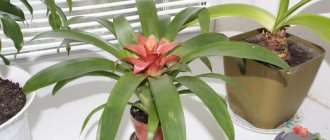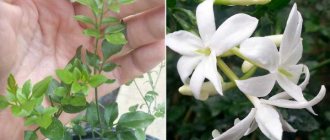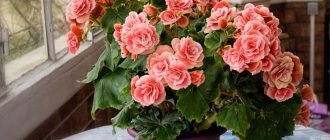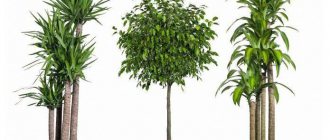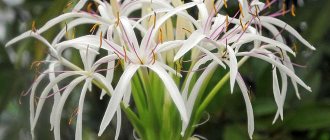Nertera is an exotic tropical plant that appeared in our area and became popular among gardeners quite recently. A distinctive feature of this plant is the berries with which the green bush is strewn, like a Christmas tree with decorations for the New Year. They can be white, yellow, orange and red, depending on the variety. In this article we will introduce you to all the nuances of caring for nertera at home.
Description
Nertera (lat. Nertera) is a genus of flowering plants in the Rubiaceae family. It is small and includes no more than 12 species of ground cover plants. The name comes from the Greek word “nerteros”, which means low, small.
For the most part, plants belonging to this genus are found in the tropical and subtropical areas of southeast Asia and the Australian continent. This representative is cultivated quite well in greenhouses and apartments, but this mainly concerns Nertera Granada.
It is no coincidence that the genus received its name. Neteru can be translated from Greek as “small”. Miniature size is a distinctive feature of representatives belonging to this genus. The plant has other names. It is often referred to as “coral berry” or “coral moss.” Of course, these names are unofficial. But they contain another feature of these representatives - a large number of small berries (plant fruits) with a rich, bright color. They are scattered all over, like beads.
Nertera is a flashy baby with a cheerful character
Nerthera is a strikingly spectacular plant. Bright, colorful and festive, she seems to be all wrapped up in a festive outfit. Some unconventional practices even endow nertera with magical properties, but it’s hard to say whether nertera really increases activity and energy. But the fact that just the sight of pots with juicy greens and a bright scattering of berries brings a smile is certain.
Nertera granadensis, known in our country not by its specific name as the Grenada or Granadian nertera, but by the popular nickname “coral berries” or “coral moss”, is a ground cover of traditionally small height. Lush cushions form long, flexible shoots that hang elegantly from the edges of the pot. In length they are limited to a modest 20 cm, but are so densely located that they completely compensate for their modest size.
The greenery of Nertera seems curly and elegant, incomparably cheerful. The leaves are richly herbaceous, rounded, about 0.5 cm in length and width. And the height of the plant itself will never exceed 10 cm (and even then in very elongated specimens).
Nertera blooms in April and May, but it is not grown for the sake of its inconspicuous miniature flower stars. The main show of this baby begins after the end of flowering, when magnificent, perfectly round and glossy fruits begin to form on the plant and then change color. They really look like beads, coral, bright and extremely elegant. Charming beads stay on the nertera bushes from August until winter, while many elegant berries perfectly enliven the autumn and winter, rather boring interior.
And it’s impossible not to watch with admiration the change of color from white and cream to yellow and orange of various shades, and then to the “final” red. Thanks to the fact that the plant displays berries of completely different colors for several months, nertera seems even more bizarre. The berries reach 1 cm in diameter, and their distinctive feature is not so much a bright color as a glossy sheen.
Nethers, despite their beauty and friendliness, contain poisonous and explosive substances. So it’s better to resist the temptation to run your hand over a curly pillow and touch the berries. True, these plants are not so aggressive that they need to be replanted in enhanced protection mode.
Note: In addition to the Granada nertera, you can also find pressed nertera on sale. For her, the main thing is greenery, and the berries only “single-piece” decorate the motley bushes.
Nertera granada. © Puffy
Appearance
The stem of the plant can be compared to a miniature vine. But its length is insignificant and does not exceed 2 cm. The stems line the surface, forming a miniature mat. The small leaves have a round, slightly elongated shape. The appearance of the flowers is inexpressive, with a predominant green-white hue of the color palette. The fruits are pea-sized with bright orange, red or brown berries. When the nertera bush bears fruit, it can be compared to cranberries or lingonberries. The fruiting period occurs in winter, which inspires the owner with a certain optimism and pleases with its beauty.
Important! The fruits of the plant cannot be eaten, due to their toxicity, although the temptation to pick the berries and eat them is present.
Most often, nertera is grown for only one season, because it is difficult to provide this flower with a proper rest period in the conditions of our apartments. And without a good winter sleep, the nertera will no longer have its former attractiveness. She will simply become unattractive in appearance. But if you show it proper care, attention and care, it will delight its owner for several years in a row.
This may be interesting: Tillandsia epiphytes: atmospheric, usniform and others
General information
The stems look like miniature vines. They spread about 2 cm from the ground, forming a colorful carpet. The opposite leaves are very small (up to 2 cm), round, less often slightly elongated. The flowers are not expressive, also very small, with a light green tint.
The pea-shaped fruits are miniature and bright when ripe. Available in four colors:
- red;
- orange;
- brown;
- black.
The ripening process is not uniform, so for some time the plant is covered with berries of different colors. They fully ripen in winter, which increases their decorative value.
Some people mistakenly believe that nertera, also known as coral moss, is annual. In fact, it can grow for several years if optimal conditions for development are created, in particular, rest for the winter is provided.
After the berries fall and the decorative effect is lost, the moss should be taken into a room with a temperature no higher than 16 ° C (a glazed and insulated balcony, loggia, or closed terrace with heating is suitable). The plant will bloom and begin to grow in March.
You may be interested in the article: Duranta: care at home.
Coral moss is a bioenergetics that increases vitality. Efficiency depends on the amount of moss and the type of other indoor flowers. Plants with succulent leaves and bright flowers should be placed next to the nertera.
Types and varieties
The genus includes various species, among which the following, most popular, representatives can be noted.
Pinned down
The plant grows in South America. It was there that it was first discovered. The leaves of this representative are distinguished by their small round shape and bright green color. During flowering, small white-green flowers bloom profusely, in place of which orange berries are formed after flowering. With good care, the diameter of the bush can reach 40 cm.
Grenada or Granadensis (Granadensis)
This type is no less popular. Nerthera grenada is found in Mexico. The diameter of the plant can reach 50 cm. The length of small leaves does not exceed 8 mm. Flowers with yellow-green tints. Subsequently, the appearance of bright orange berries can be observed on the plant.
Balfouriana
Balfour's nertera grows in New Zealand, where it is predominantly found in wetlands. It differs from other representatives of the Balfour genus in its larger berries, which have a pronounced rich orange color. The shape of the berries is similar to a pear.
Ciliata
Ciliated nertera flower
The ciliated nertera is also native to New Zealand. Differs from the previous type in a slightly smaller size. Its diameter rarely exceeds 25 cm. The fruits are fleshy orange or red. The leaves are equipped with small cilia.
Cunninghamii
Compared to other representatives of this genus, it is small in size. Rarely does its diameter exceed 20 cm. The color of the berries has distinct bright red tones.
Varieties with photos
The Nertera genus is not very diverse; there are only a few plant species, of which only three are grown at home - Nertera granadensis, constricted and blackberry. Their external differences are very minor.
Nertera pressed
The homeland of the species is South America. The leaves on creeping thin shoots are located oppositely, have a small size and a neat round shape. Flowering is short-lived and inconspicuous. The whitish moon-colored flowers are soon replaced by berries, which gradually change color from white to yellow and then to bright orange. One bush can produce a low ground cover crown of up to 40 cm; when seedlings are planted closely in open ground, a dense soft clump is formed, which is completely covered with multi-colored or orange ripe fleshy berries the size of large chickpeas.
The most famous variety of this variety is “Minestrone”, which is the smallest of all varietal and species lines.
Nerthera granadensis (Grenadian)
It is most widespread in Mexico, but can also be found in other countries in the region. It is one of the most commonly grown varieties as a houseplant. The size of an adult bush can reach half a meter in diameter, remaining very low, no more than 10 cm from the ground. The leaves are very small, 5-7 mm, with small petioles. The most famous variety of this variety is Nertera “Astrid”; most often it can be found on sale in specialized stores. The “Astrid” variety produces the largest number of coral-colored fruits and is valued for its high decorative value, which sometimes lasts until spring. Also widely known in ornamental gardening is the “Mix” variety of Nertera, which is distinguished by scattered ripening periods of its berries, thanks to which the plant pleases the eye with its multi-colored cap for a long period.
Nertera blackberry
The rarest species available for home cultivation. It is characterized by the black color of ripe berries, the size of which does not exceed 1 cm. This species looks amazing, however, it is the most capricious to care for.
Nertera is successfully used to create decorative compositions in florariums.
Caring for nertera at home
Caring for the nertera is not difficult, since it is quite unpretentious. But, nevertheless, all care activities must be carried out competently. Only in this case will the coral berry delight the owner with its appearance.
Lighting requirements
The plant loves light, but we do not recommend placing it in direct sunlight. Nertera should be placed in a place with diffused light (there should be curtains or blinds on the windows). In winter, nertera loses its attractiveness due to lack of light, so it must be periodically illuminated with a fluorescent lamp. But the lamp should not be placed too close. The light source must be no closer than 60 cm, otherwise the plant will get burned.
Temperature
In spring and summer, the room temperature should be 20-22 degrees. From October to March, the nertera needs a period of rest. At this time, the temperature should be gradually reduced to 10-12 degrees. Nertera loves fresh air, so if you want to get a healthy flowering bush next season, regularly ventilate the room where your beauty winters. With the onset of spring, when the air temperature outside is about 8-10 degrees, place the flower on the balcony. There he will feel more comfortable. But the plant must be placed in such a way as to avoid drafts and direct sunlight. As soon as the ovaries appear on the plant, bring it back indoors.
Watering and air humidity
Watering should be done as the soil dries out. There is no need to be too zealous, otherwise the roots may rot. But when there is active plant growth, abundant watering is necessary. In addition, it is recommended to spray warm water over the surface of the plant using a spray bottle.
During dormancy, watering the coral berry is reduced. Nertera does not require much moisture during this period, since the plant’s metabolism is slow.
If the air in the room is too dry, you can correct the conditions by placing wet expanded clay in the tray of the pot. It additionally moistens the soil.
This may be interesting: Aglaonema - home care
Fertilizers and fertilizers
Nertera does not need frequent feeding. It should be fed only during the growing season. Practice shows that as soon as fertilizing is carried out, coral moss immediately enters an active growth phase. Therefore, use fertilizers if you want your bush to become fluffier.
It is recommended to use complex mineral fertilizers for fertilizing. Application to the soil is carried out monthly throughout the entire growth period.
Watering and air humidity
Watering is only moderate .
Even on hot days, nertera should not be poured! Wait until a couple of days have passed after the top layer has dried and pick up a ladle of water. In winter, water minimally, barely wetting the soil.
But “coral moss” is demanding when it comes to air humidity. You need to spray it every day using warm and clean water. This is done before the first flowers appear, otherwise the liquid will spoil both the flowers and the berries. During this period, place the pot in a convenient tray with expanded clay or pebbles at the bottom. Spray the stones generously with water every day.
Tap water is harmful to plants. Buy purified distilled water or learn to let tap water sit in an open container for at least 24 hours before use.
Rules for planting and transplanting
The best time to transplant a plant is the beginning of spring, before the flowering period. If you replant the nertera when it has already bloomed, then it will certainly drop all its flowers, and you will be left without berries for a whole year. Transplantation is carried out into a larger pot as it grows. The pot should be shallow but wide, since the roots of the plant do not have the habit of growing very deep.
Certain requirements are also imposed on the soil. It should be light and loose. In order for a flower to grow actively, the soil must contain a full set of mineral elements. The best option is a composition containing turf, humus and leaf soil. All components must be present in equal parts. Be sure to add sand and peat. The best way is to purchase a ready-made composition in a specialized store. Plain soil from the street is not suitable for planting.
Mr. Summer resident warns: poisonous nertera
Nertera berries do not have a toxic effect and it is impossible to die after eating them, but they provoke a deterioration in the functioning of the gastrointestinal tract.
If there are small children in the home, it is recommended to place the plant at a height where the child cannot reach it.
The plant can be used to decorate the patio and patio. It is recommended to place the flower in a room or part of the yard where there is good lighting and in winter the temperature does not drop below +10°C.
Reproduction of nertera
Nertera is propagated by seeds, cuttings and by dividing the root. Let's talk about each of the methods.
Growing from seeds
Sowing time occurs at the end of January - beginning of February. To plant seeds, use a wide container filled with soil. There should be a drainage layer at the bottom. When sowing, one important condition must be observed - the seeds should not be placed too close to each other. The seed should be sprinkled with earth and compacted a little. A board is used for this. After sowing, the soil must be irrigated with water from a spray bottle. After this, the container is covered with any translucent material and sent to a warm place. The material for covering the container should not allow air to pass through.
The seeds will germinate unevenly. The appearance of the first shoots can be seen only after a month. Sometimes this takes 2 or even 3 months. When the seedlings appear in quite a large number, the container is transferred to a warm and bright place. Remember the “direct sunlight” rule. If the lighting is insufficient, the seedlings should be illuminated. The frequency of watering depends on the rate of drying of the top layer of soil.
Propagation by dividing rhizomes
Nertera can also be propagated by dividing the rhizome. It is better to do this at the end of summer, when the first berries begin to fall off.
- The plant is removed from the pot.
- The rhizome is freed from the ground.
- The root ball is divided into several not too small parts. If the parts are very small, the plant will bear little fruit.
- The resulting parts are planted in pre-prepared separate pots, which already have drainage and fresh soil mixture.
- Pots with planting material are placed in a cool place. This is necessary for good rooting of the plant. Once the plant is established, it will resume growth.
This may be interesting: Calathea - subtleties of care
Propagation by cuttings
Coral berry also reproduces well by cuttings. To do this, it is enough to place the cutting 2/3 of its length in water and wait for the roots to appear. To speed up the process, you can add root or any other root formation stimulator to the water. The first roots will appear in a couple of weeks. Wait until their length is about 1 cm and plant the cuttings in a pot with soil. Next, continue to care for the cutting as if it were an adult plant.
Soil and pot
When choosing soil for Nertera, remember - it must be loose, retain moisture well and allow oxygen to pass through to the roots. Flower shops sell epiphytic substrate No. 1 “Phalaenopsis”, specially designed for plants with thick roots. However, making the soil yourself is not difficult. Get river sand, peat, humus, leaf and turf soil, mix equal portions of the components - and the nutritious, airy substrate is ready.
Be sure to scald the finished mixture with boiling water and then heat it in the oven to destroy possible pests and pathogenic bacteria.
Don’t forget to put drainage on the bottom (small expanded clay, pebbles, small pieces of foam). 2-3 cm is enough. Regarding the soil layer, its level should be 1.5-2 cm below the level of the pot.
You need to loosen the soil 2 times a week so that the roots of the perennial receive air and moisture, and excess water flows into the pan. Use a special ripper from a garden store or a regular fork.
You can choose a flowerpot to suit your taste, but the material is important: often plants grow poorly precisely because of an unsuitable pot. Choose a container with smooth, thin, porous walls. A suitable material is baked clay. Pots made from it do not overheat and provide stable air exchange. Just remember to keep the container in boiled water before planting, and then rinse it with a brush to remove harmful salts and dirt that formed during firing.
Diseases and pests
Various care errors lead to diseases of indoor plants. Nertera is no exception, and can become ill if the owner does not care for it properly. Now we will describe the most common symptoms of diseases and teach you how to determine the diagnosis.
- If the nertera does not bloom and there are no fruits on it, but at the same time new leaves and shoots appear on the plant en masse, then your specimen is very hot and there is not enough moisture in the air. Move the pot to a cooler room and spray it periodically with a spray bottle.
- The shoots rot at the point of contact with the soil. Chances are you are over-watering your coral berry. Check the soil and if it is wet, stop watering the plant for 7-10 days. After this period, begin to water the nertera moderately according to all the watering rules.
- The tips of the shoots and leaves turn brown and die. Most likely, this is due to the soil in the pot drying out or getting burned due to direct sunlight. Move the pot to a more shaded place and water thoroughly.
- Shriveled berries. It seems that you were unable to provide a comfortable low temperature during the resting period of the nertera. There's nothing that can be done this season. Remember your mistakes and try not to make them in the future.
Various insect pests do not bypass the flower either. This could be aphids, whiteflies, scale insects, mealybugs, spider mites. Carefully cover the flower with a plastic bag so that none of the insects get on neighboring plants and escape. Then spray the nertera under the bag with an insecticide and leave it to stand for half an hour. After the time has passed, take the pot to the balcony, remove the bag and ventilate for 5 minutes.
Growing
The plant is kept under conditions of diffused light or partial shade.
Nertera tolerates high temperatures well, but keeping it moderately cool (+15–17°C), especially in summer, has a good effect on flowering and fruiting. On the contrary, high temperature stimulates the development of foliage, but negatively affects flowering. In winter, the plant is kept cool, but at a temperature not lower than +8°C.
Replant in early spring during the flowering period or at the end of summer. Water frequently and abundantly during the growing season, using a tray. In winter, watering is reduced, but the soil is not allowed to dry out.
Feed with complex fertilizers in the summer once a month or once every two weeks with half the dose specified by the manufacturer.
First steps after purchase
The optimal time to buy Nertera is August-September, when the plant is decorated with berries. The large number of orange “peas” also indicates the health of the plant. The presence of berries will also make it possible not to confuse Nertera with the Soleirolia plant (Helexine soleirolii), the shape of its leaves and shoots is very similar to it.
When placing Nertera, it is necessary to take into account that it requires diffuse lighting; it does not tolerate direct sunlight. However, during flowering, the lighting should be slightly brighter than usual.
Secrets and features of coral moss propagation
There are three main ways in which you can successfully replant your favorite plant, expanding the planting area.
- Seeds. An adult plant is capable of producing a lot of valuable seeds suitable for growth. The fruits of Nertera dry out and the ripened seeds spill out of the seed pods onto the soil of the flowerpot. Thus, the older stems die off, and the younger ones germinate, supporting the life of the entire plant for several years.
To propagate coral moss by seeds, it is necessary to collect the ripened seeds, dry them and, selecting the densest and strongest specimens, sow them in the prepared soil mixture of a new flowerpot.
- Dividing the bush. The mechanical process of dividing a bush consists of carefully separating the woven roots of the plant. Nertera is taken out of the flowerpot and the woven roots are torn apart with your hands, trying to damage the delicate stems as little as possible. The separated plants are planted in separate flowerpots in prepared and moistened soil.
- Cuttings. To use the cutting method, apical cuttings about 3 centimeters long are cut from an adult plant and planted in a prepared and moistened soil mixture in a garden glass or flowerpot. Having covered the planted cuttings with glass, film or a plastic bottle, send the container to a bright place where the temperature is not higher than 15 degrees Celsius. In this form, the cuttings take root.





